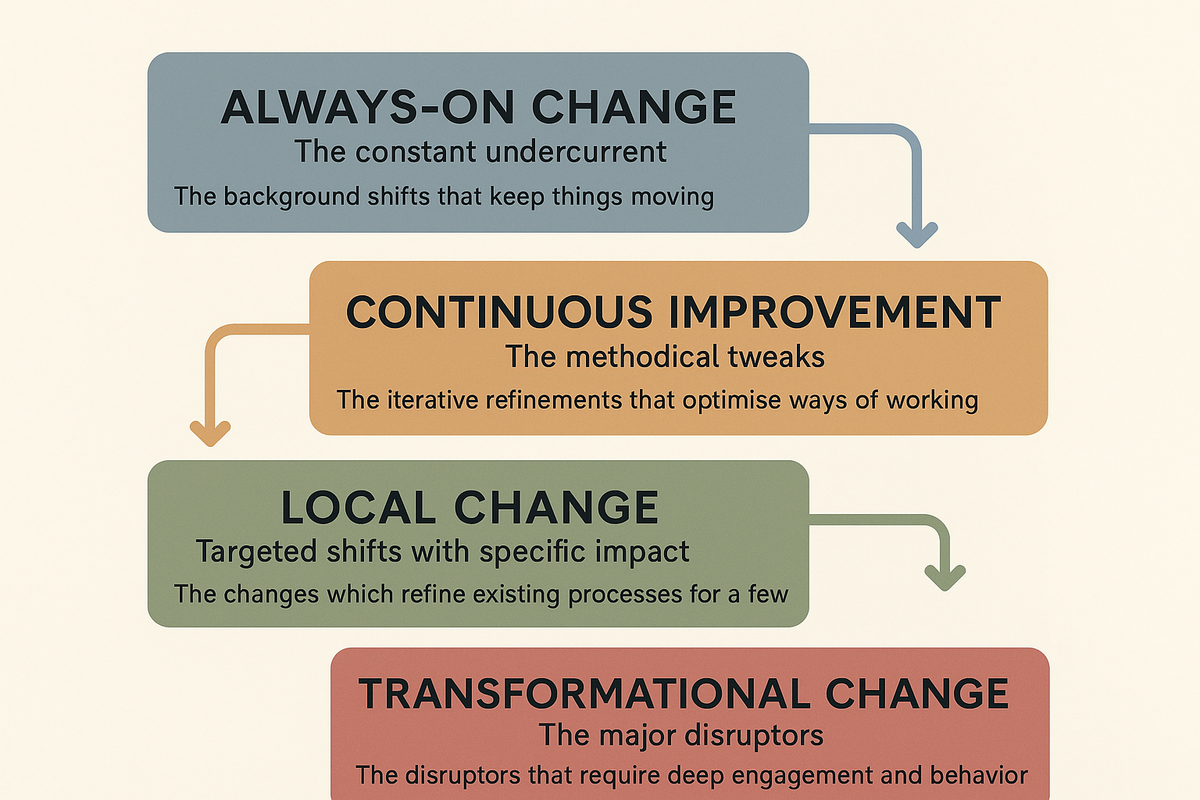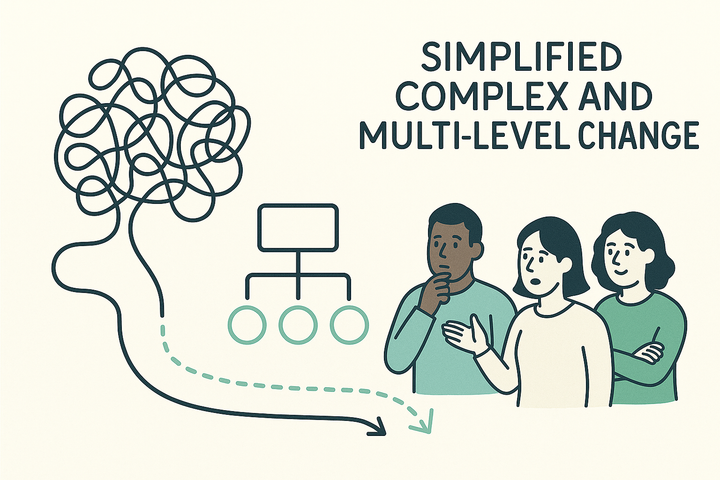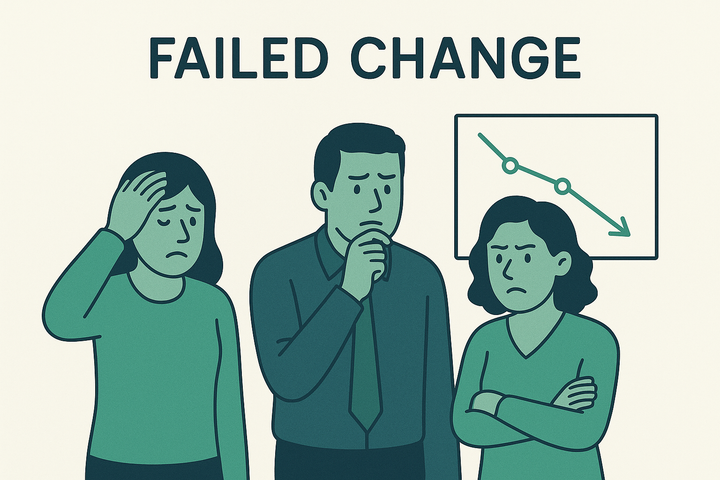The Four Types of Change and Why They Need Different Communication Approaches
Communicating every change the same way leads to fatigue and failure. Here’s how to calibrate your message to match on of the four types of change.

Not all change is created equal
One of the most common mistakes in change communication is treating every shift - big or small - like it carries the same weight.
That’s how you end up with disengagement. Not just change fatigue. Change overwhelm.
It’s the sense that every week brings another programme, another initiative, another pivot — all delivered with the same fanfare and urgency. It becomes white noise.
But here’s the truth: employees don’t experience change in neat categories. What they do respond to is how the change is communicated — what tone is used, how relevant it feels, and whether the message matches the lived impact.
Treat a minor adjustment like a revolution, and people stop listening.
Downplay a major shift, and they feel blindsided.
If you want your message to land, you need to calibrate. Match tone, timing and detail to the scale of the change itself.
A practical framework for communication-led change
The classic Balogun and Hope Hailey typology defines four types of organisational change:
- Evolutionary – Incremental, long-term change
- Revolutionary – Rapid, large-scale transformation
- Adaption – Small, localised changes
- Reconstruction – Major shifts within a steady strategy
It’s a useful lens for strategists. But it lacks one crucial link: how to communicate each type effectively.
So here’s the Rewired Work adaptation — a practical framework built for comms professionals, change leads and leaders who want their messages to move people, not just inform them.
We keep the four types, but translate them into communication terms:
- Always-On Change
- Continuous Improvement
- Local Change
- Transformational Change
Each has its own risks, rhythms, and comms approach. Here’s how to tell the difference — and what to do about it.
1. Always-On Change: The constant undercurrent
This is the low-level background hum of organisational life. The micro-adjustments that keep things ticking along:
- A new Teams feature
- An update to the expense process
- A tweak to a dashboard or login screen
Most of the time, these don’t feel like “change” at all — until they cause friction. That’s when the complaints start: “Why didn’t anyone tell us?” “What’s happened to this system?” “Where’s the old button gone?”
The communication trap
Organisations tend to fall into one of two extremes:
- Under-communicate: leaving staff to discover changes by accident
- Over-communicate: flooding inboxes with micro-updates that dilute attention
How to get it right
This type of change needs quiet, consistent visibility. Not a campaign.
- Integrate updates into existing comms channels (e.g. a “What’s New This Week” section)
- Only elevate if action is needed — otherwise, keep it discoverable
- Differentiate clearly between “FYI” and “You need to do something”
- Keep the tone light and factual — not dramatic or disruptive
The goal here is not to shout louder. It’s to keep people aware without exhausting their attention.
2. Continuous Improvement: The methodical tweaks
These are the structured, intentional changes — often underpinned by Lean, Agile or Kaizen — that refine how things are done:
- Workflow efficiencies
- Automation updates
- Better ways of collaborating
On their own, they’re not dramatic. But over time, they matter.
The communication trap
Position it too loudly and people roll their eyes: “Why is this a campaign?”
Underplay it and people think nothing’s changing: “Are we actually improving anything?”
How to get it right
- Make the benefit real: Communicate in before-and-after terms (“This used to take 5 steps. Now it takes 2.”)
- Use repetition and rhythm: Don’t oversell. Integrate into existing updates or team comms.
- Celebrate contribution: Recognise the people and teams making it happen
- Frame as part of the culture: This is how we evolve, not a new initiative every time
This is about normalising improvement, not turning every tweak into a hero moment.
3. Local Change: Targeted shifts with specific impact
Local change affects one part of the organisation — a team, function, or business unit — but feels big to them:
- A department restructuring
- A new system rollout
- A change in reporting lines
Enterprise-wide, it might not even register. But for the team involved, it is the transformation.
The communication trap
Two big ones:
- Under-communicate locally: assuming managers will handle it
- Over-communicate organisation-wide: creating unnecessary noise and confusion
How to get it right
- Target the message precisely to those affected
- Empower local leaders with the right tools: FAQs, templates, coaching
- Acknowledge the disruption: even if it’s “small,” it still matters to them
- Be explicit about scope: make it clear who is affected — and who isn’t
- Hold space for questions: small change can still trigger big feelings
You don’t need a town hall. But you do need clarity, tone, and credibility — scaled appropriately.
4. Transformational Change: The big disruptors
This is the change that shakes the ground:
- A new strategy
- A major restructure or M&A
- A culture shift or leadership overhaul
It’s the kind of change that redefines what the organisation is — and what it asks of its people.
The communication trap
The most common failure is assuming a good deck and a few roadshows will do the job. They won’t.
- If you frame it like “just another update,” it will be ignored
- If you overdo the hype without clarity, it will breed cynicism
- If you delay communication, people will fill the gaps themselves
How to get it right
- Start with context: People need the why before the what
- Paint the future state: Not just vision — show what it means for them
- Activate leaders and managers: Brief them early, properly, and personally
- Own the emotion: Don’t pretend this is just rational — it affects identity and belonging
- Repeat, return, reinforce: This is not a one-off message — it’s a narrative
Transformational change needs narrative architecture, not just messaging moments. You’re not just communicating updates — you’re helping people cross a threshold.
Final thought
You can’t treat all change the same.
And if you try, people stop listening.
Effective change communication isn’t about volume. It’s about calibration.
It’s matching your message to the moment — and knowing when to push, when to pause, and when to listen instead.
So ask yourself:
- What kind of change is this?
- Who is most affected?
- What do they need to understand, feel and do differently?
- And how do we meet them there — not in theory, but in practice?
Because when the message fits the moment, people move.
Want to sharpen how you communicate change?
Start with the Sound & Signal Review — our straight-talking diagnostic that helps you understand what’s landing, what’s missing, and what to do next.
Or, if your programme is already moving and needs a reset, the Rapid Action Accelerator helps you realign your message, your people and your plan — fast.



